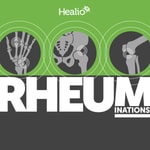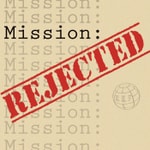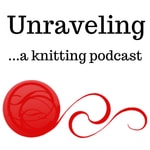Healio Rheuminations – Details, episodes & analysis
Podcast details
Technical and general information from the podcast's RSS feed.

Healio Rheuminations
Adam J. Brown, MD
Frequency: 1 episode/28d. Total Eps: 90

Recent rankings
Latest chart positions across Apple Podcasts and Spotify rankings.
Apple Podcasts
🇬🇧 Great Britain - medicine
14/06/2025#69🇨🇦 Canada - medicine
12/03/2025#96🇫🇷 France - medicine
26/02/2025#84🇫🇷 France - medicine
25/02/2025#55🇫🇷 France - medicine
03/09/2024#89🇫🇷 France - medicine
02/09/2024#65🇫🇷 France - medicine
01/09/2024#45
Spotify
No recent rankings available
Shared links between episodes and podcasts
Links found in episode descriptions and other podcasts that share them.
See all- https://www.silvermansound.com
6329 shares
- https://www.zapsplat.com
3771 shares
- https://www.zapsplat.com/
3105 shares
- https://twitter.com/HRheuminations
75 shares
- https://twitter.com/AdamJBrownMD
75 shares
- https://twitter.com/HealioRheum
75 shares
RSS feed quality and score
Technical evaluation of the podcast's RSS feed quality and structure.
See allScore global : 73%
Publication history
Monthly episode publishing history over the past years.
NSAIDs, Part 3: The rise, fall and rise again of COX-2 inhibition
Season 1 · Episode 87
jeudi 29 août 2024 • Duration 37:44
In the third episode of the NSAIDs saga, we focus on COX-2 inhibition! Did the hopes and dreams of selective COX-2 inhibition pan out? What can the rise and fall of VIOXX teach us about physiology?
- Intro 0:11
- Recap of part 1 & 2 0:28
- In this episode 1:44
- Cyclooxygenase 2 (COX-2) and the rat experiment 3:12
- What do we know about the prostaglandins? And what about COX-2 7:54
- What does prostacyclin do? 10:33
- The first COX-2 inhibitor: VIOXX 10:56
- What is COX-2 doing?: Pfizer and Merck 12:15
- Two more NSAID studies: colon cancer, Alzheimer’s disease and COX-2 inhibitors 18:41
- VIOXX: Why is myocardial infarction risk occurring? 22:34
- Animal models and the Goldilocks theory of thromboxane and prostacyclin 23:49
- PRECISION trial 30:25
- Rheum + Boards 37:14
- Thanks for listening 37:32
We’d love to hear from you! Send your comments/questions to Dr. Brown at [email protected]. Follow us on Twitter @HRheuminations @AdamJBrownMD @HealioRheum.
References:
Anderson GD, et al. J Clin Invest. 1996;doi:10.1172/JCI118717.
Funk CD, et al. J Cardiovasc Pharmacol. 2007;doi:10.1097/FJC.0b013e318157f72d.
Hennan JK, et al. Circulation. 2001;doi:10.1161/hc3301.092790.
Krumholz HM, et al. BMJ. 2007;doi:10.1136/bmj.39024.487720.68.
Nissen SE, et al. N Engl J Med. 2016;doi:10.1056/NEJMoa1611593.
Disclosures: Brown reports no relevant financial disclosures.
NSAIDs, Part 2: The Dawn of the Anti-Inflammatories
Season 1 · Episode 86
mercredi 26 juin 2024 • Duration 46:59
In this episode, we dive into the story of aspirin and the development of ibuprofen, ending with the experiments that showed the mechanism of how aspirin actually works.
- Intro 0:12
- Review of part 1 0:28
- In this episode 1:04
- Blocking prostaglandins and willow leaves 2:26
- Edward Stone 3:45
- Johann Andreas Buchner 4:16
- The chemical structure of salicylic acid and creating the synthetic compound 4:44
- Dr. TJ MacLagan: The first trial in 1876 and treating acute rheumatism 5:16
- Felix Hoffmann: manipulating salicylic acid and aspirin 8:47
- How widespread was the use of aspirin for rheumatoid arthritis? 12:04
- 1938: problems with aspirin and endoscopies 14:58
- 1950s: long-term use of aspirin and chronic renal impairment 17:12
- Dr. Lawrence Craven: the use of aspirin to treat myocardial infarction 18:13
- Overview of what we’ve learned so far 20:48
- Stewart Adams: the development of ibuprofen 21:40
- A paper lost to time 23:29
- How do you test if a drug is anti-inflammatory? 25:25
- How do you make better aspirin? 26:55
- 1960: a trial comparing ibuprofen, baby aspirin and prednisone in patients with rheumatoid arthritis 30:03
- Aspirin, ibuprofen and other NSAIDs 32:49
- Nobel Prize winner Dr. John Vane 33:40
- Dr. Vane: what triggered prostaglandin production? 35:42
- Another guinea pig experiment 37:37
- Nobel Prize winner Dr. Bengt Samuelsson 39:00
- Interesting tidbits: early studies looking at the side effects of NSAIDs 40:01
- 1968: gastric ulcer formation and prostaglandins in rats 40:25
- 1973: renal blood flow and prostaglandins in dogs 41:53
- 1974: aspirin vs ibuprofen vs indomethacin for the heart 44:03
- Aspirin vs ibuprofen vs indomethacin 44:20
- On the next episode 46:09
- Thanks for listening 46:37
We’d love to hear from you! Send your comments/questions to Dr. Brown at [email protected]. Follow us on Twitter @HRheuminations @AdamJBrownMD @HealioRheum.
References:
Adams SS. Inflammopharmacology. 1999;doi:10.1007/s10787-999-0002-3.
https://www.aspirin-foundation.com/history/the-aspirin-story/.
Buchanan WW, et al. J Rheumatol. 2002;29(6):1321-3.
Cryer B, et al. Gastroenterology. 1999;doi:10.1016/s0016-5085(99)70545-7.
Desborough MJR, et al. Br J Haematol. 2017;doi:10.1111/bjh.14520.
Halford GM, et al. Platelets. 2012;doi:10.3109/09537104.2011.632032.
Harris SC, Fosdick LS. Theoretical considerations of the mechanisms of antipyretic analgesia. NWU Bull. 1952;53: 6–9.
Jasani MK, et al. Ann Rheum Dis. 1968;doi:10.1136/ard.27.5.457.
Robert A, et al. Gastroenterology. 1968;55(4):481-7.
Disclosures: Brown reports no relevant financial disclosures.
The Environment and Autoimmunity, Part 1
Season 1 · Episode 77
mercredi 12 juillet 2023 • Duration 38:00
This episode delves into the history of the hygiene hypothesis. What do we know about different exposures changing risk for asthma and allergies, and do these exposures have the same protection for autoimmunity?
· Intro 0:12
· In this episode 0:18
· Hygiene hypothesis 0:33
· Allergic rhinitis (or Hay fever) 2:32
· Pollen and the allergy skin test 8:58
· Exposure and cleanliness 10:22
· Allergic rhinitis and Cree Native Americans 11:51
· Appendicitis 13:10
· Family size and asthma 14:36
· Rural versus urban populations 17:41
· Dust 18:31
· Children, day care and infections 22:43
· The “old friends” theory 28:29
· Farming and allergies 30:07
· The Amish and the Hutterites 33:02
· Mice, dust and asthma 34:47
· Thanks for listening 37:40
Disclosures: Brown reports no relevant financial disclosures.
We’d love to hear from you! Send your comments/questions to Dr. Brown at [email protected]. Follow us on Twitter @HRheuminations @AdamJBrownMD @HealioRheum.
References:
Emanuel MB. Clin Exp Allergy. 1988;doi:10.1111/j.1365-2222.1988.tb02872.x.
Flohr C, et al. Clin Exp Allergy. 2010;doi:10.1111/j.1365-2222.2009.03346.x.
Genuneit J. Pediatr Allergy Immunol. 2012;doi:10.1111/j.1399-3038.2012.01312.x.
Karvonen AM, et al. J Allergy Clin Immunol. 2019;doi:10.1016/j.jaci.2019.07.035.
Perkin MR, et al. Front Allergy. 2022;doi:10.3389/falgy.2022.1051368.
Rantala AK, et al. Epidemiol. 2020;doi:10.1097/EDE.000000000001163.
Sangrador CO, et al. Allergol Immunopathol (Madr). 2018;doi:10.1016/j.aller.2018.03.006.
Stein MM, et al. N Engl J Med. 2016;doi:10.1056/NEJMoa1508749.
Strachan DP. BMJ. 1989;doi:10.1136/bmj.299.6710.1259.
Weber J, et al. Am J Respir Crit Care Med. 2015;doi:10.1164/rccm.201410-1899OC.
An Afternoon with the Glaucomfleckens: On hypermobility and physician burnout
Season 1 · Episode 76
mercredi 28 juin 2023 • Duration 46:01
On this special episode of Rheuminations, I interview comedian and ophthalmologist William Flanary, MD, and Kristin Flanary, also known as the Glaucomfleckens, on hypermobility and physician burnout.
Kristen Flanary highlights what it's like to live with hypermobility, and Dr. William Flanary discusses his thoughts on physician burnout and using their podcast, Knock Knock, Hi, as comedy relief.
· Intro 0:11
· In this episode 0:45
· Interview with Dr. William and Kristin Flanary, also known as Doctor and Lady Glaucomflecken 2:49
· Rheumatology and ophthalmology overlap 3:11
· Can you tell me a few things about yourselves? 7:48
· Kristin Flanary, MA: when did you notice your hypermobility and when did you start having complications from it? 12:19
· Do you ever fully dislocate or do you kind of feel like you’re about to? 19:53
· Chest compressions and William Flanary 25:23
· Have you done any bracing? 26:24
· Dr. Linda Bluestein, @hypermobilityMD, on the Glaucomfleckens podcast 30:24
· William Flanary, MD: can you talk about your experience with physician burnout? And are you optimistic about AI solving the physician burnout problem? 31:16
· Artificial Intelligence with Cardiologist Dr. Eric Topol | Knock Knock, Hi with the Glaucomfleckens, @EricTopol 37:01
· Can you tell us more about your podcast, Knock Knock, Hi? 41:06
· Thank you 44:59
Disclosures: Brown and the Flanarys report no relevant financial disclosures.
William E. Flanary, MD, is an ophthalmologist and part-time comedian, also known as Dr. Glaucomflecken. You can follow him on Twitter @DGlaucomflecken.
Kristin Flanary, MA, is a marketing and communications specialist, also known as Lady Glaucomflecken. You can follow her on Twitter @LGlaucomflecken.
We’d love to hear from you! Send your comments/questions to Dr. Brown at [email protected]. Follow us on Twitter @HRheuminations @AdamJBrownMD @HealioRheum.
The Black Death and Autoimmunity
Season 1 · Episode 75
lundi 3 avril 2023 • Duration 31:45
Was your psoriasis caused by the Black Death? Learn more than you might have wanted to know about the Black Death and delve into the data on the immunologic/autoimmune ramifications of wiping out nearly half of Europe.
· Intro 0:11
· In this episode 1:09
· The Black Death 1:24
· The History of IV Immunoglobulin episode 2:07
· How the Black Death happened 4:07
· How many people died from the Black Death? 6:49
· Record keeping 6:53
· The modern immune system, the Black Death and HIV 8:43
· What is CCR5? 8:55
· Current data on autoimmune diseases 10:35
· ERAP2 15:55
· How yersinia pestis kills you 21:04
· The inflammasome 22:03
· The Inflammasome for Dunces episode 22:09
· Mediterranean fever and mouse model 24:49
· Takeaways 30:20
· Summary 30:59
Disclosures: Brown reports no relevant financial disclosures.
We’d love to hear from you! Send your comments/questions to Dr. Brown at [email protected]. Follow us on Twitter @HRheuminations @AdamJBrownMD @HealioRheum.
References:
Wheelis M. Emerg Infect Dis. 2002;doi:10.3201/eid0809.100536.
Ratner D, et al. PLoS Pathog. 2016;doi:10.1371/journal.ppat.1006035.
Park YH, et al. Nat Immunol. 2020;doi:10.1038/s41590-020-0705-6.
Patin E. Nat Immunol. 2020;doi:10.1038/s41590-020-0724-3.
Galvani AP, et al. Proc Natl Acad Sci USA. 2003;doi:10.1073/pnas.2435085100.
Vascular Ehlers Danlos Syndrome for the Rheumatologist, Pt 2: Extra-Cellular Matrix Reloaded
Season 1 · Episode 74
mardi 28 février 2023 • Duration 41:57
In this episode we explore ways in which the extracellular matrix can be manipulated, including the story of doxycycline, TGF-beta in Marfan syndrome and whether beta blockers can reduce vascular events in vascular EDS.
· Intro 0:12
· Review of previous episode 0:28
· In this episode 2:26
· The pressure against the vessels 4:06
· The pressure against the wall 8:44
· Matrix metalloproteinases 10:16
· Tadpole study – collagen breakdown 10:35
· Tetracycline antibiotics 14:05
· Rat model – periodontal disease and hydroxyproline 14:24
· Chemically modified tetracyclines 20:14
· Mouse model – tetracycline use 22:00
· Tetracyclines and other autoimmune conditions 23:22
· Marfan syndrome 24:45
· Fibrillin and Marfan syndrome 28:48
· TGF-beta 29:36
· Mouse model – Marfan syndrome and fibrillin 31:14
· ARBs and TGF-beta 33:51
· TGF-beta and vascular EDS 37:25
· Back to the mouse model 38:38
· Protein kinase C 39:56
· Summary 40:26
Disclosures: Brown reports no relevant financial disclosures.
We’d love to hear from you! Send your comments/questions to Dr. Brown at [email protected]. Follow us on Twitter @HRheuminations @AdamJBrownMD @HealioRheum.
References:
Bowen CJ, et al. J Clin Invest. 2020;130:686-698.
Brooke BS. Lancet. 2010;doi:10.1016/S0140-6736(10)61155-5
Dietz HC, et al. Am J Med Genet C Semin Med Genet. 2005;doi:10.1002/ajmg.c.30068.
Dubacher N, et al. Cardiovasc Res. 2020;116:457-465.
Golub LM, et al. SAGE. 1998;doi:10.1177/08959374980120010501.
Gross J, et al. PNAS. 1962;doi:10.1073/pnas.48.6.1014
Habashi JP, et al. Science. 2006;312:117-121.
Morissette R, et al. Circ Cardiovasc Genet. 2014;7:80-88.
Vascular Ehlers-Danlos Syndrome, Part 1
Season 1 · Episode 73
mardi 31 janvier 2023 • Duration 36:38
Dive into vascular Ehlers-Danlos syndrome. What is it? How does it present? Get clues to its diagnosis and learn more about collagen than you ever wanted to know.
- Intro 0:12
- In this episode 0:17
- Why vascular Ehlers-Danlos syndrome? 0:28
- Case study: Dr. Mories 2:20
- What can we learn about vascular Ehlers-Danlos syndrome? 05:02
- Collagen and elastin 05:57
- Collagen: horses and glue 07:07
- More about collagen 10:35
- Why is it a problem to miss a little bit of collagen? 14:14
- The problem in vascular Ehlers-Danlos syndrome 15:06
- The history of vascular EDS 15:41
- How is vascular Ehlers-Danlos syndrome diagnosed? 16:36
- A vascular Ehlers-Danlos syndrome diagnosis 22:33
- Mouse models 23:29
- Clinical and genetic features of vascular Ehlers-Danlos syndrome 24:39
- Question of vasculitis 25:55
- The skin: the most common symptom of vascular EDS 28:00
- Family history, de novo mutations and pregnancy 29:43
- Surgery or vascular intervention 31:39
- How do patients do in the long-term? 32:54
- Summary 34:00
- Preview of part 2 35:42
- Thanks 36:25
Disclosures: Brown reports no relevant financial disclosures.
We’d love to hear from you! Send your comments/questions to Dr. Brown at [email protected]. Follow us on Twitter @HRheuminations @AdamJBrownMD @HealioRheum.
References:
Barabas AP. J Cardiovasc Surg (Torino). 1972;13(2):160-7.
Chow MJ, et al. Biophys J. 2014;doi:10.1016/j.bpj.2014.05.014.
Liu X, et al. Proc Natl Acad Sci USA. 1997;doi:10.1073/pnas.94.5.1852.
Mories A. Scott Med J. 1960;5:269-72.
Pepin M, et al. N Engl J Med. 2000;doi:10.1056/NEJM200003093421001.
Pepin MG, et al. Genet Med. 2014;doi:10.1038/gim.2014.72.
Piez KA. Matrix Biol. 1997;doi:10.1016/s0945-053x(97)90037-8.
Pope FM, et al. Proc Natl Acad Sci USA. 1975;doi:10.1073/pnas.72.4.1314.
Wagenseil JE, et al. J Cardiovasc Transl Res. 2012;doi:10.1007/s12265-012-9349-8.
Zilocchi M, et al. AJR Am J Roentgenol. 2007;doi:10.2214/AJR.07.2370.
Making Sense of Sensory Ganglionopathies, Part 2
Season 1 · Episode 72
mercredi 18 janvier 2023 • Duration 29:24
In this episode, Dr. Benjamin Claytor walks us through his approach to suspected sensory ganglionopathies. I also cover other neurologic complications of Sjogren’s syndrome and some interesting history on vitamin B6.
- Intro 0:12
- In this episode 0:46
- Neurologic complications of Sjogren’s Syndrome 1:55
- Intro of Dr. Benjamin Claytor 6:00
- The interview 6:49
- Case study: process of diagnosis 7:17
- Dorsal root ganglion in Sjogren’s 10:46
- Facial numbness in sensory ganglionopathies 11:42
- Dorsal root ganglion biopsies 13:36
- Prognosis of sensory ganglionopathies vs other distal neuropathies 14:03
- Sensory loss and weakness 15:51
- Sensory ataxia 16:24
- Attacks on the dorsal root ganglion 18:25
- Loss of fibers in the dorsal root ganglion and regrowth 19:21
- Treating cancer and sensory ganglionopathies 20:03
- Idiopathic patients and treatments 20:45
- Interview wrap-up 21:43
- Pearls of wisdom from the interview 22:11
- History of sensory ganglionopathies 23:35
- Thanks 29:09
Disclosures: Brown and Claytor report no relevant financial disclosures.
Benjamin Claytor, MD, is assistant professor of neurology at the Neuromuscular Center at Cleveland Clinic.
We’d love to hear from you! Send your comments/questions to Dr. Brown at [email protected]. Follow us on Twitter @HRheuminations @AdamJBrownMD @HealioRheum.
References:
Antopol W, et al. J Neuropathol Exp. 1942;doi:10.1097/00005072-194207000-00006.
Pavlakis PP, et al. J Autoimmun. 2012;doi:10.1016/j.jaut.2012.01.003.
Schaumburg H, et al. N Engl J Med. 1983;doi:10.1056/NEJM198308253090801.
Making Sense of Sensory Ganglionopathies and Sjogren’s Syndrome
Season 1 · Episode 71
jeudi 15 décembre 2022 • Duration 37:36
A sensational (or lack thereof) series on the signs and symptoms of the spellbinding sensory ganglionopathies.
- Intro :12
- Today’s episode :16
- Anatomy review 1:32
- Large fiber vs. small fiber nerves 4:47
- Case presentation 6:11
- Neurologic examination of patient 8:31
- What is pseudoathetoid posturing? 10:11
- What does it mean to be length independent? 14:30
- What is sensory ganglionopathy? 16:19
- How did the differential evolve throughout history? 18:50
- How do things get out of the synovium? 23:19
- Why does rheumatology get involved? 26:12
- Case series of patients with Sjogren’s syndrome and sensory ganglionopathy 28:20
- How do we treat it? 32:48
- Summary 34:09
- Thank you 36:59
Disclosures: Brown reports no relevant financial disclosures.
We’d love to hear from you! Send your comments/questions to Dr. Brown at [email protected]. Follow us on Twitter @HRheuminations @AdamJBrownMD @HealioRheum
References:
Amato AA, et al. N Engl J Med. 2020;doi:10.1056/NEJMra2023935.
Denny-Brown D. J Neurol Neurosurg Psychiatry. 1948;doi:10.1136/jnnp.11.2.73.
Griffin JW, et al. Ann Neurol. 1990;doi:10.1002/ana.410270313.
Malinow K, et al. Ann Neurol. 1986;doi:10.1002/ana.410200416.
Long COVID: Some facts, unanswered questions and implications for rheumatology – Part 2
Season 1 · Episode 69
lundi 10 octobre 2022 • Duration 24:19
In part two, Leonard Calabrese, DO, discusses the symptoms of long COVID and the role that rheumatologists play in diagnosing and treating patients with long COVID.
Brought to you by Tremfya.
- Intro 1:06
- Calabrese introduction 1:11
- In this episode 1:36
- Defining long COVID 1:49
- Reviewing symptoms of long COVID 2:51
- Long COVID fatigue 3:44
- Studies and research on fatiguability 4:38
- Phenomena of post-exertional malaise 6:18
- Chronic fatigue syndrome 7:25
- Neurocognitive dysfunction 7:52
- Co-factors of intercurrent mood disorders and neurocognitive dysfunction 9:30
- Pandemic-related sequelae 10:30
- What about pain? 10:53
- Long COVID pain and criteria for fibromyalgia 11:40
- Pandemic-related long COVID 13:16
- Diagnoses of long COVID 14:46
- Immunopathogenesis 15:27
- What about infections and autoimmunity? 17:50
- What about treatments for long COVID? 19:28
- Validation of long COVID 20:52
- What do rheumatologists have to do with long COVID? 21:56
- Wrap up 21:13
- Thanks 24:02
Disclosures: Calabrese reports no relevant financial disclosures.
We’d love to hear from you! Send your comments/questions to Dr. Brown at [email protected]. Follow us on Twitter @HRheuminations @AdamJBrownMD @HealioRheum









